
|
A DETAILED CONTEMPORARY SCALE MODEL FOR H.M.PADDLE TUG ESCORT, CIRCA 1896
carved and painted hull with scored decking with polychromed wood and metal fittings as appropriate, twin stayed funnels, central panelled bridge and over-bridge, paddle boxes with fret-cut tops and feathering paddles, forward mast with standing and running rigging and other details, mounted on raised launching blocks within contemporary ebonised case with plate inscribed to front Paddle Tug "Escort" H.M. Dockyard Devonport Fawcett Builders, 1896 - overall 14 x 26¼ x 8½in. (36 x 66.5 x 21.5cm.)
£800-1,200
The iron paddle tug Escort (525 tons) was built by Fawcett of Preston, launched 28th July, 1896, and sold to J.A. White for breaking on 31st May, 1922.
|
|
  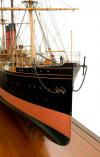  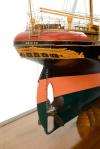   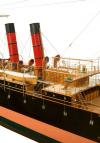   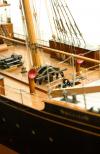 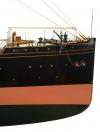 |
A FINE AND HIGHLY ORIGINAL 1:48 SCALE BUILDER'S MODEL FOR THE LINER S.S. MEXICO, BUILT FOR THE CIA. MEXICANA TRASATLÂNTICA BY ROBERT NAPIER & SONS, GLASGOW, 1884
the 104in. hull carved from laminated pine with Plimsoll marks, oxidised brass anchors with stocks and studded chain, hinged port lids with raising chains, oxidised brass propeller with bolted blades, and finely carved decorative boxwood stern mouldings incorporating company name, the lined boxwood and white decks complete with silvered, gilt and oxidised metal fittings including bitts, bollards, anchor winch, capstan, wood capped and metal deck rails with chains over, wash screen, carved wooden ventilators, coal chute covers, companionways, spare anchors, raised superstructure with open bridge with helm, binnacle, telegraphs, lamps, fire buckets, panelled passenger accommodation, twin raked funnels with stays, safety valve extension pipes and whistle, covered lifeboats in davits, one fully-fitted with cross boards, thwarts and oars, engine room lights, two cranes with weighted chain hooks, a pair of signalling cannons mounted amidships with one further, possibly for life-lines, aft, raked masts the fore and main with yards, standing and running rigging with blocks and tackle, cleats and belaying pins, and many other fine details, mounted on launching blocks within original glazed wooden case with twin builder's plates, mounted on table stand with six turned legs. Overall measurements - 78 x 116 x 27½in. (198 x 295 x 70cm.); Table - 29in. (74cm.) high; together with a letter from William Beardmore to J.M. Bowker, dated 3rd September 1925 confirming the model's availability for sale from their premises at £50
£20,000-30,000
This lot is available for viewing at the DoubleTree by Hilton Hotel, Imperial Road - please see map on inside back cover for details
The last of three near-identical sisters all built by Robert Napier & Sons Ltd for the Compãnia Mexicana Trasatlántica in 1883-4, they registered 4,142 tons, measured 400ft with 44ft beam and were powered by a three-cylinder compound engine driving a single screw which could develop 14 knots. Well appointed within for her day, her 98 First Class passengers travelled in a manner that rivalled a modern Cunarder and she had further accommodation for 108 Second and 784 Third Class. Entering service in May 1884 on a route from Vera Cruz to Liverpool via Bermuda, the venture proved too ambitious and by 1887 with mounting losses the Mexico, along with her sisters Oaxaca and Tamaulipas were listed for sale by receivers in Liverpool where all three were sold to the Italian line La Veloce Linea di Navigazione Italiane a Vapore ("The Fast Italian Steam Navigation Line") and Mexico, now re-named Duchessa di Genova, had her funnels painted buff with a red star and successfully plied a route between Genoa and South America until 1901 when she was transferred to the New York run, and was broken up in Genoa in December 1905. In 1889, however, she was one of several ships caught up in what became known as the 'Dresden Affair' - named after the eponymous Norddeutscher Lloyd liner which arrived in Buenos Aires with 1,772 mostly Irish migrants who had been encouraged with assisted travel to emigrate to South America. Her arrival on the 15th February unfortunately coincided with the arrival of the Duchessa di Genova carrying a further 1,000 Italian migrants, and several other smaller steam ships also packed with migrants. With no facilities or accommodation in town, the overwhelmed local authorities were forced to deny disembarkation to the ships and passengers aboard began to develop sickness, malnourishment and dehydration. Suffering was intense and casualities mounted to the extent that immigration programmes were suspended overnight and questions were raised in the House of Commons; many premature deaths were assigned to this incident over the next few years.
|
|
   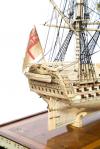  |
A LARGE, FINELY CARVED AND WELL-PRESENTED EARLY 19TH CENTURY NAPOLEONIC FRENCH PRISONER-OF-WAR BONE SHIP MODEL FOR A FIRST RATE SHIP OF THE LINE TRADITIONALLY IDENTIFIED AS H.M.S. CALEDONIA
the 22in. planked and pinned hull with carved main wale with gilt foil, three deck broadsides of protruding guns on spring recoil action, carved Roman warrior form figurehead, depicted with sword, plume and billowing cloak, finely carved quarter galleries and stern with balconies, the planked and pined deck with details including metal anchors with bound bone stocks, deck rings, belaying rails, capstan, belfries with brass bells, wale deck with deck lights, compass house, companionways, deck lights, bound masts with yards, stunsail booms, standing and running rigging with blocks and tackle, and other details, mounted on bone cradle rest secured to fine marquetry inlaid wooden display base with carved bone curtain trim with foil backing, contained within later ebonised glazed case with plate inscribed H.M.S. Caledonia First Rate of 120 guns, circa 1810 - 27½ x 37½ x 14¼in. (70 x 95.5 x 36cm.)
£25,000-35,000
Provenance: With Trevor Phillips & Sons, London circa 1998
|
|
 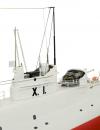 |
A WELL-PRESENTED 1:85 SCALE MODEL OF THE EXPERIMENTAL CRUISER-COMMERCE RAIDER SUBMARINE H.M.S. X.1 [1923]
modelled from his own researches by M. Butler and comprising a carved 48in. hull with brass planes, anchors and propellers, closed torpedo tubes and water inlets, jack staff, deck rails, fire direction, twin guns in casemates, conning tower with raised radio aerial, range finder, snorkel and periscope and other details, mounted on polished brass rests to oak display base with plaque and plexiglass cover. Overall measurements - 17 x 61 x 14in. (43 x 155 x 35.5cm.)
£2,500-3,500
At 363ft long, X1 was, for a time, the largest submarine in the world. Built at Chatham Dockyard and displacing nearly 2800 tons, she could make 19.5kts surfaced and about 9kts submerged using two salvaged German engines from U-126 and two Admiralty designs. Although fitted with six torpedo tubes in her bows, she was intended to tackle her targets using her twin pairs of 5.2in. quick-firing guns mounted in turrets fore and aft of her conning tower. Based on the late WWI German design for submarine cruisers she was laid down in November 1921 but her intended role as a commerce raider was made illegal by the 1922 Treaty of Washington and so she was completed in great secrecy and declared to be a submersible 'cruiser' capable of hunting destroyers. Manned by 100 crew with 11 officers, she was double hulled and her 1in. thick pressure hull had a designed diving depth of 350 feet but, in fact, never went below 200 feet. She proved a stable gun platform and handled well, however she was beset by mechanical problems from the outset and never achieved her full potential. She was laid up in 1933 and finally broken in 1937 - the only R.N. vessel built after World War I to be broken before the onset of World War II.
This lot will be available for viewing at Imperial Road
|
|

|
A LARGE ENGINEER'S MODEL OF H.M. SUBMARINE TUNA, CIRCA 1940
cast in solid brass with fittings including keel, torpedo tubes, planes, twin propeller shafts with feathers, rudder, conning tower with quick firing guns, periscope, snorkel, radio wires etc., mounted on a tapering wooden base, with name plate - 6 x 20½in. (15 x 52cm.)
£800-1,200
Tuna was a 1090 ton T class submarine built by Scotts of Greenock, laid down in 1938 she was launched in 1940 with German-built engines. A successful submarine, she sank several U-Boats, but is perhaps most famously associated with the transport of the 'Cockleshell Heroes' to the Gironde estuary where she disembarked a dozen men and canoes in a daring but successful operation against German shipping. Sadly only two survived the operation, but their fame was such that they were immortalised in the eponymous 1955 film. Tuna was broken up in 1946
|
|
  |
A DESIGN AUTHORITY DIAGNOSTIC REFERENCE MODEL FOR H.M.SUBMARINE CONQUEROR, BUILT BY CAMMELL LAIRD, 1970
the 34in. ebonised hull carved from the solid in two halves with articulated veins, rudder and seven blade brass propeller, the starboard half pulling apart on section of base to reveal hand-coloured technical profile drawing of the internal layout including reactor, wardroom, torpedo tubes etc., secured by a lift-off conning tower with plug fittings to hull and complete with snorkels, periscopes etc., the conjoined halves mounted on chock stands to display base with carved laminated name plate and contained and secured within fitted travel case of issue - case 16 x 40¼ x 7in. (41 x 102 x 18cm.)
£800-1,200
Provenance: Design Authority, Bath (closed 2012)
The Design Authority was an M.O.D. department that provided technical support to all three services wherever located around the globe. The model was most likely supplied by Cammell Laird as the information contained within would have been classified as Top Secret for the duration of Conqueror's career.
The 4000 ton Improved 'Valiant' Class nuclear attack submarine Conqueror was laid down by Cammell Laird on the 5th December, 1967, launched eighteen months later and completed in November 1971. Perhaps her greatest moment has also remained her most controversial - the sinking of the General Belgrano on 2nd May, 1982 during the Falklands campaign which has provoked impassioned debate ever since. She was sold for breaking in 1990 but as of 2017 was still at H.M.N.B. Devonport and being considered for public opening.
|
|

|
A BUILDER'S WATERLINE MODEL FOR THE NET LAYER H.M.S WARDEN BUILT FOR THE MINISTRY OF DEFENCE BY RICHARDS, LOWESTOFT, 1989
the carved and ebonised hull numbered A368, with grey decks and yellowed superstructure with details including anchors and winches, bitts, spare anchor, glazed bridge with internal fittings, overbridge with binnacle, search lights and comms mast, quick launch rafts in brackets, twin funnels with ladders, winches, raised gantry aft, deck rails and other details, depicted in a carved and painted sea with maker's plates, contained within a metal bound glazed case - 12½ x 28 x 11¼in. (32 x 71 x 28.5cm.)
£300-500
This lot will be available for viewing at Imperial Road
|
|
  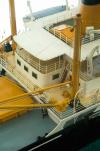 |
A FINE BUILDER'S WATERLINE MODEL FOR THE M.V.S TAYBANK AND TWEEDBANK, BUILT FOR THE BANK LINE LTD BY WILLIAM DOXFORD & SONS, SUNDERLAND, 1963-4
the laminated and carved ebonised hull with grey painted decks and yellow painted wood and metal fittings as appropriate including deck rails, anchors with chains and winches , bitts, companionways, covered holds with rigged derricks, superstructure with overbridge, funnel with comms mast and lamps, awnings, covered lifeboats in davits, emergency aft helm and controls, and other details, mounted on a textured waterline sea with builder's plate within glazed wooden case of issue - 17 x 72 x 17in. (43 x 183 x 43cm.)
£2,000-3,000
This lot will be available for viewing at Imperial Road
|
|
  |
A BUILDER'S MODEL FOR THE HULL TRAWLER LADY LAVINIA [H 160], BUILT BY COOK, WELTON & GEMMEL LTD. FOR JUTLAND AMALGAMATED TRAWLERS, 1935
the laminated and carved 38in. hull with bilge keels, oxidised brass propeller, anchor and rudder, lined and lacquered boxwood deck with fittings including anchor winch with studded chain, deckrails, bitts, stove pipe, companionways, crew squint, port-and-starboard fish sorting hatches, netting guides, raked masts with standing rigging, lines with blocks and lamps, net winch, central superstructure with enclosed steering house with gilt-plated fittings to roof including inverted compasses, range finder, wireless aerial, ventilators, stayed funnel with livery and whistle, engine room lights, steering chains, furled spanker sail, covered lifeboat and other details, mounted on turned wooden supports to baize-lined display base with plates and original glazed wooden cover (later base and plates). Cased measurements - 22½ x 50½ x 13in. (57 x 128 x 33cm.)
£2,000-3,000
The Lady Lavinia, a 417 ton steam trawler, was returning from Norwegian waters when she ran into a massive storm and foundered, probably on Saturday, 7th March, 1938, with the loss of all 16 hands. For many years this model decorated a local (Hull) fish and chip shop where the case was gloss painted several times, recent conservation has revealed the original mahogany.
This lot will be available for viewing at Imperial Road
|
|
  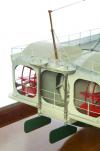 |
A BUILDER'S MODEL FOR THE 'EL HILAL' CLASS QUARTER-WHEEL PUSHER TUGS BUILT FOR THE SUDANESE GOVERNMENT AGENCY BY YARROW & CO. LTD, GLASGOW, 1954
the carved and painted hull with lined lower and painted upper decks, painted and lined upper superstructure with wood veneer below, painted stern paddles with twin rudders, deck rails with painted meshing, covered bridge with gold plated helm and telegraph, lamps over, companionways, blue-painted funnel and slatted deck bench and other details, mounted on four ebonised metal columns within original wooden glazed display case with ivorine builder's plate and wooden feet (plate warped). Overall measurements - 24 x 43½ x 18¼in. (61 x 110.5 x 46.5cm.)
£1,500-2,500
The name 'El Hilal' does not appear in the Yarrow lists and so must be the name for a class of six identical pusher tugs built in 1954 for the Sudanese Government. These were then dis-assembled, shipped to Sudan and re-assembled in situ as was commonly done for this type of river steamer from the mid-19th century. With the end of Empire in sight, however, this must have been one of the last such orders ever dispatched. The six vessels represented by this model are: Hurriyah; Imatong; Lado; Marra; Tagoog; and Taka. However their fates are unknown at present.
This lot will be available for viewing at Imperial Road
|
|

|
A RARE 1IN:32FT SCALE WATERLINE MODEL OF H.M.S. HAWKINS, MODELLED BY NORMAN OUGH, 1926
the hull carved from the solid with painted sides and natural deck, carved and painted fittings including capstan, bitts, anchors with painted chains, main and secondary armament, bridge with fire control, masts with radio aerials and signal lanyards, stayed funnels, covered boats in davits, and other details, mounted on raised cloth-covered plinth with maker's plate, name and scale plates, and contained within ebonised wood glazed cover with exhibition label to one corner. Cased measurements - 6½ x 23½ x 6½in. (16.5 x 60 x 16.5cm.)
£800-1,200
Norman Ough (1898-1965) was principal model maker to both the National Maritime Museum and Imperial War Museum and made commissions for many others as well as private clients. A considerable eccentric, he was sometimes found half starved having forgotten to eat for days being so wrapped in his work. His models are considered amongst the finest evocations of the genre, capturing the essential spirit of the ship and, at an age when few, if any short cuts were available, did not see the need to over-crowd detail. This model was presumably a private commission for someone connected to Hawkins, another example of this ship is held in the Imperial War Museum, Catalogue No. MOD1637.
H.M.S. Hawkins was one of the five 'Cavendish' class cruisers ordered in 1915. Designed primarily for trade protection, Hawkins was built at Chatham where she was laid down in June 1916. Displacing 9,750 tons (12,190 deep loaded) and measuring 605 feet in length with a 65 foot beam, she could steam at 30 knots and carried a surprisingly heavy main armament of 7-7.5in. guns. Launched in October 1917, she was not completed until after the end of the Great War and her first tour of duty was as flagship to the 5th Light Cruiser Squadron on the China Station where she served from 1919-29. After a spell in the East Indies, she was rearmed in 1939 just in time for active duty in the Second World War during which she initially served as Flagship to Rear Admiral Sir Henry Harwood immediately after the Battle of the River Plate; she was scrapped in 1947.
|
|

|
A COLLECTION OF RECOGNITION MODELS, PROBABLY AMERICAN, 1940S
Comprising 28 wood and metal waterline models for various navies and classes of ship, each named underneath and now secured to shelf with title to front and contained within plexiglass fronted display case - overall 18¾ x 33¾in. (48 x 85.5cm.)
£200-300
|
|
  |
A FINE BUILDER'S HALF-BLOCK FOR THE S.V. MONARCH, BUILT BY GREEN'S YARD, BLACKWALL, LONDON, 1844 AND OWNED BY THE SHAW SAVILLE LINE, 1866
the hull carved from 1in. laminated wood, varnished below the waterline and ebonised above with faux gun ports, finely carved figurehead and scrollwork, tinted stern and quarter lights, plain mast with cut-away bowsprit, mounted on blue display board with gilt chamfered edge, inscribed Monarch 1444 tons. Overall measurements - 15¼ x 66in. (39 x 167.5cm.)
£4,000-6,000
Built by the famous Blackwall yard of R. & H. Green for themselves, the 1,444 ton Monarch was notable for quality of build - the planks next to the keel were American elm 5in. thick, then teak to the African oak wales, and more teak to the topsides, capstan and interior work. Described by a contemporary observer as a splendid mercantile vessel... pierced for 50 guns and capable of carrying a greater number.. there were 30 cabins over two decks and a 36 x 18ft dining room. By the time Shaw Savill bought her in 1866 she was somewhat passé but she served them well and was used first for their New Zealand run, and then Australia where she remained until sold to R.W. Morris after seven years service.
|
|

|
THE BUILDER'S HALF-BLOCK MODEL FOR THE RUSSIAN PASSENGER PADDLE STEAMER KRIKOON, BUILT BY MITCHELL & CO., TYNESIDE, 1858
the carved hull with black topsides, foliate decoration to bow and stern, with painted deck with cutaway funnel and mast, the painted paddle box named in Cyrillic, mounted on display board inscribed Krikoon [Hulk] No. 46 - 6¼ x 36in. (16 x 91.5cm.)
£250-350
|
|
  |
THE BUILDER'S MIRROR-BACKED HALF-MODEL FOR THE GENERAL PURPOSE CARGO SHIP S.S. CRAIGFORTH, BUILT BY A. RODGER & CO. FOR THE CRAIG LINE, 1907
the laminated and carved hull finished in varnish with black-painted topsides, cut-away masts and funnel, lined superstructure and silver-plated metal fittings, mounted on a mirror within original wooden case with angled end mirrors and builder's plate (rear mirror replaced). Overall measurements 23 x 99½ x 9½in. (58.5 x 253 x 24cm.)
£1,800-2,500
Registered at 2900 tons, her name was changed to Iskondar in 1914, the next year she was seized by Turkey but was then sunk by gunfire from Russian light cruiser Pamiat Merkuria off Kozlu on the 4th May.
|
|

|
AN ATTRACTIVE HALF-BLOCK BUILDER'S MODEL FOR THE IRON PASSENGER PADDLE STEAMER GIRONDE ET GARONNE, BUILT FOR CIE MARITIME GIRONDE ET GARONNE, BORDEAUX BY HUGH MCINTYRE & CO., PAISLEY, 1880
carved from ¼in. laminated yellow pine with ebonised topsides, lined paddle box inscribed GIRONDE ET GARRONNE No.2, cut-away raked twin funnels and mast, mounted on a contrasting wood waterline display board with ivorine yard number '59' to centre - 9 x 59in. (23 x 150cm.)
£800-1,200
A passenger ferry of 237 tons measuring 203.2ft with a 20.5 breadth and draft of 8.4ft, her engines were built by Hutson & Corbett of Glasgow and could develop a healthy 90bhp. She served on the eponymous rivers her name suggests, but no record of her fate has been found to date.
|
|
  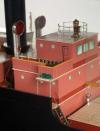 |
A BUILDER'S MIRROR-BACK MODEL FOR THE S.S PAIGNTON BUILT FOR THE WILTON STEAM SHIP COMPANY BY MURDOCH & MURRAY LTD, GLASGOW, 1919
the laminated and carved hull with gilt brass propeller, ebonised top sides and lined and lacquered boxwood decking, with plated fittings including anchors with studded chains and winches, deck rails, bitts, hose drums, companionways covered hatches, cutaway masts with derricks, derrick winches, painted pink superstructure with bridge with lined door and tinted windows and brass binnacle over and fire buckets, ventilators, cutaway funnel with safety valve extension pipe, covered lifeboat in davits, emergency helm and binnacle and other details, mounted on original front silvered mirror within glass fronted wooden case with angled end mirrors and ivorine builders plate, overall measurements - 20 x 75 x 10in. (51 x 190.5 25.5cm.)
£1,500-2,000
Provenance: The Wilton Steam Ship Company and thence by decent
Completed in October 1919, this 1514 ton general cargo ship was sold in 1921 to the London & Edinburgh Shipping Co. Ltd and renamed Ossian. Having survived the hostilities of the Second World War, she hit a stray mine on 3rd February, 1947 whilst in passage between Emden and Plymouth with a cargo of wood and sank.
|
|
   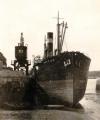 |
A BUILDER'S MIRROR-BACK MODEL FOR THE S.S. HAYTOR, BUILT FOR T. & C. WILTON & CO. LTD, BY JOHN CROWN & SONS LTD, SUNDERLAND, 1925
the laminated and carved hull with bilge keel, white painted propeller, black topsides with Plimsoll marks, lined boxwood decks with painted metal and wood fittings including anchors with studded chains and winches, deck rails, hose drums, cleats, companionways, covered hatches with lined covers, rigged masts with derricks and winches, ventilators, spare anchor, superstructure with open bridge with telegraph, binnacle and wheelhouse, stove pipe, stayed liveried funnel with ladder, engine room ventilators and lights, lifeboats in davits and other details, mounted on twin silvered baluster supports to front silvered mirror within original wooden case with angled end mirrors, ivorine plate and presentation plate to Clifford Wilton, Chairman, dated 1981 to front. Overall measurements - 22½ x 69 x 10in. (57 x 175 x 25.5cm.); together with a set of annotated builder's blueprints for the ship, an album of Box Brownie photographs of the ship and deck scenes, a company account book for various cargoes and period photograph of Haytor upon completion in 1925; and quantity of Wilton photographs of S.S. Bovey Tracey
£1,200-1,800
Provenance: Wilton's Steam Ship Company and thence by decent
This 1189 ton cargo ship was sunk by mine on the 26th July, 1940 in ballast between London and Blyth with the loss of Charles Douglas, Second Engineer.
|
|
  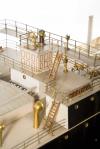 |
A FINE BUILDER'S MODEL OF THE TANK STEAMERS NERITE AND COWRIE BUILT FOR M. SAMUEL & CO. BY SIR W. G. ARMSTRONG, MITCHELL & CO., NEWCASTLE-ON-TYNE, 1896
the laminated and carved hull with lowered companionway painted with lined decks with detailed gilt deck fittings including anchors with studded chain and winches, bitts, ventilators, deck rails, lamp houses, companionways, gantry with rails, covered oil hatches, cutaway masts with derricks, raised superstructure with bridge, glazed wheel house with open helm and telegraph over, fire buckets, engine room with lights and cutaway funnel and extension pipes, fitted boats in davits and much other fine detail, finished in pink, black and white and mounted on four plated columns to display base with builder's plates and contained within original glazed mahogany case with table. Overall measurements - 52½in x 113 x 24in. (133.3 x 287 x 61cm.); Case - 31in. (79cm.) high
£8,000-12,000
Both these 4,893 tankers were transferred to Shell in 1898. On 13th March, 1902, the tanker Bulysses grounded badly during a sandstorm whilst in Kabret (Great Bitter Lake), Egypt. Nerite came to her assistance with the plan of drawing off some oil, proceeding to Suez to deposit it in tanks and return until the stranded ship was light enough to float off the sandbar. In their wish to make haste, Nerite's crew filled her tanks to the brim without taking into account oil expansion in heat. The cargo burst the aft coffer dam and the oil flowed freely into the stokehold setting the ship ablaze. A total loss, she was towed to Genoa for breaking and Shell built another of the same name in 1904 which lasted until 1931; Cowrie enjoyed a normal career and was broken in 1929.
Viewing by appointment only - full set of additional images available via charlesmillerltd.com or on request by email.
|
|
 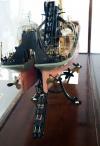  |
A FINE BUILDER'S MODEL OF THE TWIN SCREW STERN WELL BUCKET AND SUCTION HOPPER DREDGER PARITUTU BUILT FOR THE NEW PLYMOUTH HARBOUR BOARD, WELLINGTON, NEW ZEALAND, BY FLEMING AND FERGUSON LTD, PAISLEY, 1910
the laminated and carved hull with silver plated and oxidised brass fittings as appropriate, mounted at an oblique angle on decorative oxidised brass Art Nouveau stands over mirror located under hull doors, finished in pink and grey with lacquered decks with original mahogany glazed case and table with builder's plate - 57 x 56 x 14½in. (145 x 142 x 37cm.)
£3,000-5,000
This lot will be available for viewing at Imperial Road
|
|
  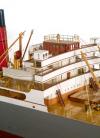 |
A FINE BUILDER'S MIRROR-BACK HALF MODEL FOR THE CARGO SHIP S.S. PORT CAROLINE BUILT FOR THE DOMINION AND COMMONWEALTH LINE LTD (PORT LINE) BY WORKMAN CLARK & CO. LTD, BELFAST, 1919
the laminated and carved hull painted red below the waterline and grey above with bilge keel, gilt-brass propeller and rudder with lined boxwood decking, replete with gilt brass fittings as appropriate and including anchor with studded chain, winches and crane, cleats, bitts, ventilators, deck rails, wooden companionways, covered lined hatches, rigged masts and derricks with blocked tackle and winches, raised white painted superstructure with bridge and wheel house with binnacle over, water tank, telegraph and lamps, covered lifeboats in davits, stayed funnel with safety value, extension pipe and hooter, engine room lights, aft superstructure with emergency steering and binnacle and other details, mounted on two turned gilt brass columns on original front silvered mirror within original carved display case with external ivorine builder's plates and mounted on later metal table stand - cased 32 x 104½in. (81 x 265.5cm.) overall; 65½in. (166.5cm.) high
£3,000-5,000
Built for the Dominion & Commonwealth Line (re-branded Port Line in 1937), Port Caroline was the first of a class of ten ships and her service speed was a healthy 14 knots. At the start of her maiden voyage she collided with Ellerman Line's City of Valencia but thereafter she did the Australian meat run without incident - including throughout World War II. After a brief period of use by the Ministry of Food as a meat storage ship, she was scrapped at Blyth in February 1950.
This lot will be available for viewing at Imperial Road
|
|
 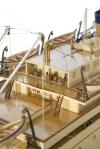  |
A BUILDER'S MODEL FOR THE PASSENGER/CARGO M.V.S ISIPINGO, INCHANGA AND INCOMATI BY WORKMAN CLARK (1928) LTD, BELFAST FOR THE BANK LINE, 1933-4
the laminated and carved hull with bilge keels, gilt brass propellers, lowered companionways, lined portholes and rudder, with lined boxwood decks with gilt and oxidised brass fittings as appropriate and including anchors with studded chain and winches, deck rails, bitts, ventilators, companionways, covered hatches, racked masts rigged with derricks and derrick winches, lined superstructure with bridge and overbridge with binnacle and wireless point, water tanks, fitted lifeboats in davits, stayed funnel with safety value, extension pipe and hooter, engine lights, slated deck benches, passenger cafe with tables and seats, the lower decks with ventilators and other details, mounted on four turned wood green columns secured raised baize lined display base with signed written details within original wood bound glazed case with solid top - 27½ in x 66½ x 17in. (70 x 169 x 43cm.)
£3,000-5,000
These three 7,369 ton sisters were designed and built for the Bank Line Ltd (Andrew Weir & Co.) India-Africa route. The Inchanga received a Doxford engine salvaged from the hapless S.S. Bermuda (built by Workman Clark & Co. in 1928) which had caught fire in 1931 and had a slightly better speed than her 15-knot sisters. She and Isipingo both served out their full careers and were both sold for breaking in 1964; the Incomati was less fortunate and was torpedoed and shelled by U-508 on 18th July, 1943 between Takoradi and the Middle East, sinking with the loss of one life, but 212 survivors.
This lot will be available for viewing at Imperial Road
|
|
  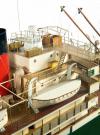 |
A BUILDER'S MODEL FOR THE T.S.M.V. SACRAMENTO BUILT BY CAMMELL LAIRD, BIRKENHEAD FOR ELLERMAN'S WILSON LINE LTD, HULL, 1945
the laminated and carved hull with lined wooden and red painted decks with gilt fittings including anchors with studded chains and winches, ventilators, deck rails, hose drums, companionways, bitts, cleats, rigged masts with derricks and ladders, covered hatches, covered lifeboats in derricks, white painted superstructure with bridge and overbridge, awning stanchions, stayed funnel with whistle, rangefinder, aft superstructure with duplicate controls and much other fine detailing, mounted on four painted turned columns to display base with builder's plates within original glazed wooden case and mounted on associated wooden table base. Overall measurements 75 x 130½ x 32in. (190.5 x 331.5 x 81.5cm.); case 41in. (104cm.) high
£6,000-8,000
Viewing by appointment only - full set of additional images available via charlesmillerltd.com or on request by email.
|
|
  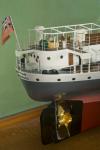 |
A FINE BUILDER'S MODEL FOR THE M.V.S. EGYPTIAN, IONIAN, PATRICIAN, AND VENETIAN BUILT FOR ELLERMAN AND PAPAYANNI LINES LTD BY JOSEPH L. THOMPSON & SONS LTD, SUNDERLAND, 1947
the laminated and carved hull with grey painted lined decks and details, mainly painted, fittings including anchors with studded chain and winches, deck rails, ventilators, finished in light and dark red and grey with white upperworks and grey and brown decks, bitts, companionways, rigged masts with ladders, covered hatches, raised superstructure with brass-lined portholes, glazed bridge with bell and wooden overbridge with binnacle, rangefinder, awning stanchions, four covered lifeboats in davits, liveried funnel with whistle and safety value extension pipes, aft superstructure with emergency steering and telegraphs, and much other fine detail, mounted on four plated columns on display base with builder's plate in original glazed mahogany case with painted rear panel and table (paint craquelure throughout) - 7½ x 112 x 30in. (19 x 284.5 x 76.2cm.); Case - 37½in. (95.5cm.) high
£6,000-8,000
Viewing by appointment only - full set of additional images available via charlesmillerltd.com or on request by email.
|
|
 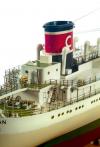  |
A BUILDER'S BOARDROOM MODEL FOR THE TANKER KURDISTAN BUILT FOR COMMON BROTHERS LTD, NEWCASTLE, BY HARLAND & WOLFF LTD, BELFAST, 1950
modelled by Sunderland Model Engineering Co., laminated and carved hull with bilge keels, lowered companionways, four blade gilt brass propeller, green painted lined decks with painted and plated fittings as appropriate including anchors with chains and winches, deck rails, bitts, companionways, raised gantries with handrails, masts rigged with derrick, ventilators, deck lights, oil hatch covers, raised white painted superstructure with white lined decks, bells, over deck, lockers, comms mast, covered boats in davits, spare propeller, aft superstructure with engine room lights, liveried funnels with hooter, emergency steering with compass and the details , mounted on two turned oxidised brass mounts to raised display base with builder's and maker's plates, contained within wooden glazed case of issue with brass owner's plaque to front and associated table stand. Overall measurements - 56 x 74½ x 18in. (142 x 189 x 46cm.); Case 25in. (63.5cm.) high
£3,000-5,000
Built for the Hindustan Steam Shipping Co. Ltd, and run by Common Brothers, she was sold to Bulgarian owners and re-named Arda in 1961 and was broken at Split in 1977.
This lot will be available for viewing at Imperial Road
|
|
 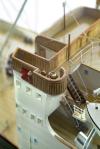  |
A FINE BUILDER'S MODEL FOR THE PASSENGER/CARGO FERRY M.V. IRISH COAST, BUILT FOR COAST LINES LTD BY HARLAND & WOLFF, BELFAST, 1952
the carved and laminated hull with bilge keels, main wale, lined passenger and vehicle access points, portholes and gilt brass propellers, with lined yellow decks with ebonised and painted fittings as appropriate including anchors with winches and chains, bitts, hose drums, bell, deck rails, companionways, covered hatches, masts rigged with derricks and winches, white superstructure with overbridge with binnacle, helm and telegraphs, rangefinder, mast, eight covered lifeboats in davits, livered funnel, wood cap deck rails, back-to-back passenger benches, emergency helm and other details, mounted on four turned gilt columns to raised display base with builder's plates, contained within original wood bound display case with table stand. Overall measurements - 41 x 72 x 17in. (104 x 183 x 43cm.) including stand; case 26½ x 66in. (67 x 168cm.)
£4,000-6,000
This lot will be available for viewing at Imperial Road
|
|
  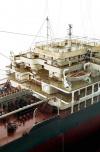 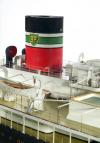 |
A DETAILED STATIC DISPLAY MODEL OF THE S.S. BRITISH VICTORY BUILT BY VICKERS-ARMSTRONG (SHIPBUILDERS) LTD FOR BP TANKERS LTD, 1954, AND MODELLED BY BASSETT-LOWKE
the laminated and carved hull with red painted lined decks and painted and plated fittings including anchors with studded chain, deck rails, anchor winches, bitts, bollards, ventilators, companionways, covered oil hatches with pipework, wooden gantries with rails and intermittent cowls, raised superstructure with awning stanchions, over bridge with binnacle and telegraphs, rangefinder and comms masts, benches with wooden slats, wood capped deck rails, hose drums, swimming pool, fitted lifeboats in davits, spare anchor and propeller, liveried funnel and much other fine detail, mounted on six ebonised columns within original glazed light oak case with maker's plates on table stand of issue. Overall measurements - 68 x 134½ x 26in. (173 x 342 x 66cm.); Case - 39in. (99cm.) high
£5,000-8,000
Viewing by appointment only - full set of additional images available via charlesmillerltd.com or on request by email.
|
|
  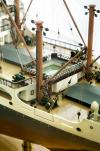 |
A BUILDER'S MODEL OF THE PASSENGER / CARGO SHIP M.V. CITY OF PORT ELIZABETH, BUILT FOR ELLERMAN LINES LTD BY VICKERS ARMSTRONG LTD, NEWCASTLE, 1952
the laminated and carved wooden hull with gold plated propellers, boarding companionways, bilge keels and rudder, lined and painted decks with fittings including anchors with studded chain, winches and hawse pipes, ventilators, companionways, covered hatches, masts with rigged derricks, superstructure with fitted open bridge over main, rangefinder, signal mast, liveried funnel with horn, engine room lights, open lifeboats in davits, swimming pool, aft emergency steering and other details, mounted on four silvered supports to satinwood display base with ivorine builder's plates and glazed wooden case. Cased measurements - 32 x 80 x 19½in. (81.5 x 203 x 49.5cm.)
£6,000-8,000
The first of a class of four new ships built for the London-Cape Town service (with sisters City of Exeter; City of York and City of Durban), they were notable for their luxurious accommodation. Registered at 13,363 tons, she measured 541ft with a 71ft breadth and a draught of 28½ft, with 607,000 cubic feet of stowage. Her twin screw Doxford diesel engines provided a service speed of 16½ knots completing the passage in 16days for her 107 First Class only passengers. Sold in 1971 to Greek owners and used for cruising, she was broken up in 1980.
This lot will be available for viewing at Imperial Road
|
|
 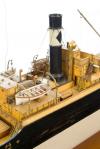  |
THE BUILDER'S MODEL FOR THE S.S. CORLAND BUILT FOR CORY COLLIERS LTD, BY S.P. AUSTIN & SONS LTD, SUNDERLAND, 1917
the laminated and carved hull with gilt brass four-blade propeller ebonised above the waterline with lined and lacquered boxwood decks, with gilt brass fittings including anchors with studded chain, anchor winches, deck rails, ventilators, companionways, lined hatch covers with derricks and winches, open bridge with binnacle, telegraphs and lanterns, stayed livered funnel with safety valve extension pipe and hooter, fitted boats in davits, engine room lights, emergency helm and other details, mounted on two ebonised pedestal stands on raised moulded display base with ivorine builder's plate within original glazed wooden case. Overall measurements - 20 x 58½ x 12in. (51 x 149 x 30.5cm.); together with a fleet register for Cory Colliers Ltd completed in manuscript with index of vessels to front, and owner's inscription for Mr R. Beale, Marine Superintendent, leather bound with gilt titles
£3,000-5,000
Provenance: Presented to Mr Greenacre, marine engineer and then ship broker at Cory, and thence by descent
Built and launched for Cory as Buffs in 1917, she was renamed and remained Corland in 1920 for the rest of her career. Her untimely end came on 5th February, 1942 when she was caught by German aircraft at anchor about 2½ miles north of 62 B buoy (near the Wash) carrying 4,800 tons of coal from Blyth to London and bombed. Fortunately her crew of 27 were able to abandon her without loss of life.
This lot will be available for viewing at Imperial Road
| END OF SALE | |
Our next sale will be held on Tuesday of 5th November, closing for entries on 6th September. | |
|

